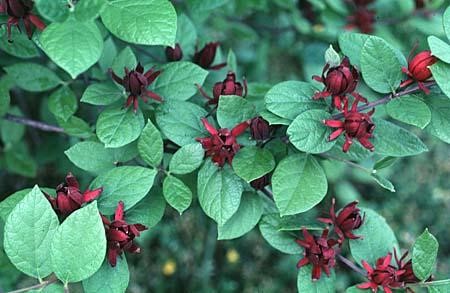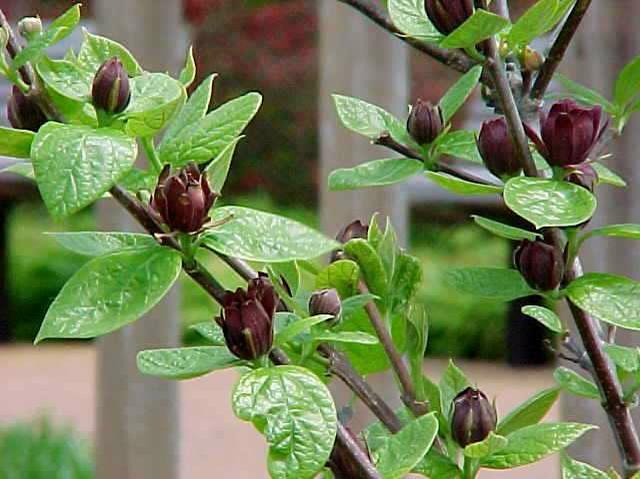Calycanthus floridus: Carolina Allspice
 Latin name: Calyanthus floridus
Latin name: Calyanthus floridus
Common name: Carolina Allspice
Flowers: Brown or red blooms from May to July 10
Fruit: Brown seed pods in the fall 13
Height & Width: 6-10ft x 6-12ft 12
Type: Deciduous shrub 7
Habit: Dense, mounded 13
Wetland indicator category**: FACU 5
Texture: Medium 13
Growth rate: Medium 13
Light: Full sun 7
Moisture: Medium 12
Soil*: Moist, well-drained soil 13
Zones: 4-9 19
Origin: Pennsylvania, south to Florida 16
Ecosystem benefits: Butterfly nectar at blooms, insects feed on flowers 13
Features: Low maintenance, is tolerant of clay soil, attracts butterflies and pollinators, resistant to deer and heat 13, fragrant, showy flowers, adapts to many types of soil, and is very resistant to disease and insect problems. 10.
Siting: Can be used near entrances or pathways as a fragrant bush, or as a shrub border and in a native garden 12.
Care: Plant crown at soil level 18. At planting, water the roots and surrounding area slowly and deeply. Keep soil moist until plant is established, then apply enough water to thoroughly moisten the root zone when the soil is dry or during drought. Modify water recommendations to reflect site drainage and rainfall. Apply 3” of mulch over the planted area. Do not allow mulch to touch the plant stems 18.
Pests: Plants are relatively pest resistant if cultural preferences are met 18.
- USDA SC Invasive Plant Species Web site at http://www.invasivespeciesinfo.gov/plants/main.shtml
- SC Exotic Plant Pest Council Web site at http://www.se-eppc.org/southcarolina/
Author: Emma Hanson
Image source: https://plants.ces.ncsu.edu/plants/euonymus-americanus/
Sources:
- Armitage, A. (2001). Armitage’s manual of annuals, biennials, and half-hardy perennials. Portland, OR: Timber Press.
- Armitage, A. (2006). Armitage’s native plants for North American gardens. Portland, Oregon: Timber Press.
- Armitage, A. (2008). Herbaceous perennial plants: A treatise on their identification, culture, and garden attributes. Athens, GA: University of Georgia.
- Clemson Cooperative Extension Home and Garden Information Center.(2011). Flowers fact sheets. Retrieved from https://hgic.clemson.edu/category/flowers/
- Clemson Cooperative Extension Home and Garden Information Center.(2011). Groundcovers & vines fact sheets. Retrieved from https://hgic.clemson.edu/category/groundcovers/
- Clemson Cooperative Extension Home and Garden Information Center.(2011). Trees. Retrieved from https://hgic.clemson.edu/category/trees/
- Clemson Cooperative Extension Home and Garden Information Center.(2011). Shrubs. Retrieved from https://hgic.clemson.edu/category/shrubs/
- Dirr, M. A. (2009). Manual of woody landscape plants. Champaign, IL: Stipes Publishing.
- Gilman, E. F. (1997). Trees for urban and suburban landscapes. Albany, NY: Delmar Publishers.
- Lady Bird Johnson Wildflower Center University of Texas at Austin. (2012). Native plant information network. Retrieved from http://www.wildflower.org/explore/
- McMillan, P., Plant taxonomist Clemson University, personal communication.
- Missouri Botanical Garden Kemper Center for Home Gardening. Plant finder. Retrieved from http://www.mobot.org/gardeninghelp/plantfinder/Alpha.asp
- North Carolina State University (2005). Plant fact sheets. Retrieved from http://www.ces.ncsu.edu/depts/hort/consumer/factsheets/index.html
- Strother, E. V., Ham, D. L., Gilland, L. (2003) Urban tree species guide: Choosing the right tree for the right place. Columbia, SC: South Carolina Forestry Commission.
- University of Florida, IFAS Extension. (2011). Southern trees fact sheet. Retrieved from http://edis.ifas.ufl.edu/department_envhort-trees
- USDA . Plant profile. (n/d).Retrieved from http://plants.usda.gov/java/
- USDA. Plant wetland indicator status. (n/d). Retrieved from http://plants.usda.gov/wetland.html
- Vincent, E., Environmental horticulturist Clemson University, personal communication.
- The Morton Arboretum. TREES & plants. Retrieved from https://www.mortonarb.org/trees-plants
*Soil pH is determined using a professional soil test. Contact your Clemson University County Extension service for assistance www.clemson.edu/extension/. Click on “local offices”.
**2012 Plant Wetland Indicator categories (quantitative derived) http://plants.usda.gov/wetinfo.html
|
Indicator Code |
Indicator Status |
Comment |
|
OBL |
Obligate Wetland |
Almost always is a hydrophyte, rarely in uplands |
|
FACW |
Facultative Wetland |
Usually is a hydrophyte but occasionally found in uplands |
|
FAC |
Facultative |
Commonly occurs as either a hydrophyte or non-hydrophyte |
|
FACU |
Facultative Upland |
Occasionally is a hydrophyte but usually occurs in uplands |
|
UPL |
Obligate Upland |
Rarely is a hydrophyte, almost always in uplands |
 Latin name: Calyanthus floridus
Latin name: Calyanthus floridus
Common name: Carolina Allspice
Flowers: Red-brown, showy blooms 12
Fruit: Brown seed capsules, not showy but interesting 12
Height & Width: 10' x 12’ 12
Type: Perennial 12
Habit: Shrub 12
Wetland indicator category**: FACU 17
Texture: Medium 12
Growth rate: Fast 12
Light: Full sun to part shade 12
Moisture: Medium 12
Soil*: Organically rich loam 12
Zones: 4-9 12
Origin: South Carolina and the southeastern United States 16
Features: An easily maintained plant Carolina Allspice begins to flower in May with fragrant red-brown blooms. Dark green leaves turn yellow in the fall, while seed capsules grow and persist through the winter. This is a very fragrant plant that releases aroma through blooms and the bruising of tissues, such as leaves. Its scent is said to be a mix of pineapple, strawberry, and banana 12.
Siting: Performs ideally in well drained, organically rich, loamy soils. It prefers full sun and in part shade it will typically grow taller reaching for the light. 12
Care: Plant crown at soil level. 18 At planting, water the roots and surrounding area slowly and deeply. Keep soil moist until plant is established, then apply enough water to thoroughly moisten the root zone when the soil is dry or during drought. Modify water recommendations to reflect site drainage and rainfall. Apply 3” of mulch over the planted area. Do not allow mulch to touch the plant stems. 18
Pests: Plants are relatively pest resistant if cultural preferences are met.
Author: Alexander Smolka
Sources 1-18 found on Sources page
